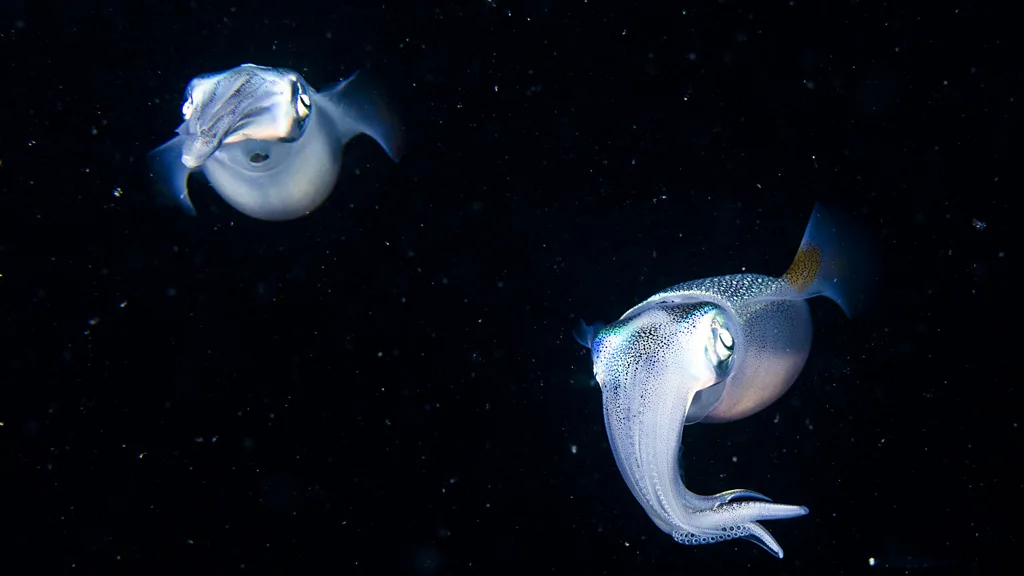Physical Address
304 North Cardinal St.
Dorchester Center, MA 02124

The firefly squid (Watasenia scintillans) is a captivating creature that turns the dark depths of the ocean into a glowing spectacle. This small cephalopod, native to the waters of Japan,
is renowned for its bioluminescent abilities, which have fascinated both scientists and the general public. In this article, we explore the unique characteristics of the firefly squid, from its biology and behavior to its cultural significance and conservation concerns. Each line offers insights into a world where light and life intertwine in one of nature’s most beautiful displays.
The firefly squid’s most remarkable feature is its ability to produce light through bioluminescence. This process occurs when the enzyme luciferase interacts with the molecule luciferin, emitting light with minimal heat. The squid’s body is equipped with photophores—light-producing organs—on its tentacles, head, and body, allowing it to emit a mesmerizing blue glow.
This bioluminescence serves various purposes, including attracting prey, deterring predators, and communicating with other squids.
”Principle of the squid’s counter-illumination camouflage. When seen from below by a predator, the bioluminescence helps to match the squid’s brightness and colour to the sea surface above.”
Unlike many other bioluminescent creatures, the firefly squid can control its light emissions with incredible precision. This ability to switch its lights on and off allows the squid to create complex patterns, which can confuse predators or attract mates.
Its mastery of counter-illumination—matching the light intensity from above to blend into the ocean surface from below—demonstrates an advanced adaptation to its environment. This not only helps the squid avoid predators but also makes it a more effective hunter.
“Diagram illustrating the basic features of a generic squid. The mantle, eyes, arms, tentacles, buccal membrane, and typical suckers are all shown in this diagram.”
The firefly squid’s life cycle is closely tied to the changing seasons, particularly in Toyama Bay, where millions of these squids come to the surface to spawn in the spring. This event, known as “Hotaruika,” transforms the bay into a shimmering sea of blue light. The life cycle of the firefly squid is relatively short, with most individuals living only about one year. After spawning, the adults die, leaving behind a new generation to continue the luminous display.
In the marine food web, the firefly squid plays a crucial role. As a predator, it feeds on small fish and crustaceans, using its bioluminescence to lure prey into its reach. As prey, it is an essential food source for larger marine animals, such as whales, dolphins, and seabirds. The firefly squid’s presence indicates the health of its marine environment, making it a valuable species for ecological studies and conservation efforts.
In Japan, the firefly squid holds a special place in both culture and cuisine. The annual sight of millions of firefly squids lighting up Toyama Bay has inspired art, literature, and festivals. This natural wonder draws tourists from around the world, eager to witness the squid’s luminous dance. In Japanese cuisine, the firefly squid is considered a delicacy, often enjoyed during the spawning season when the squid is freshest.
Despite its abundance, the firefly squid faces threats from climate change, overfishing, and habitat degradation. Rising ocean temperatures and acidification could disrupt its spawning patterns, while overfishing may deplete its populations. Conservation efforts are essential to protect this bioluminescent marvel and ensure that future generations can continue to marvel at its glowing displays.
The firefly squid is a testament to the beauty and complexity of life beneath the waves. Its bioluminescence is not just a spectacle; it is a vital part of its survival strategy and a symbol of the intricate balance of marine ecosystems. For those who have the privilege of witnessing the firefly squid’s light show, it is a reminder of the wonders of the natural world and the importance of preserving these delicate ecosystems. Through continued research and conservation, we can ensure that the firefly squid continues to light up the oceans for years to come.